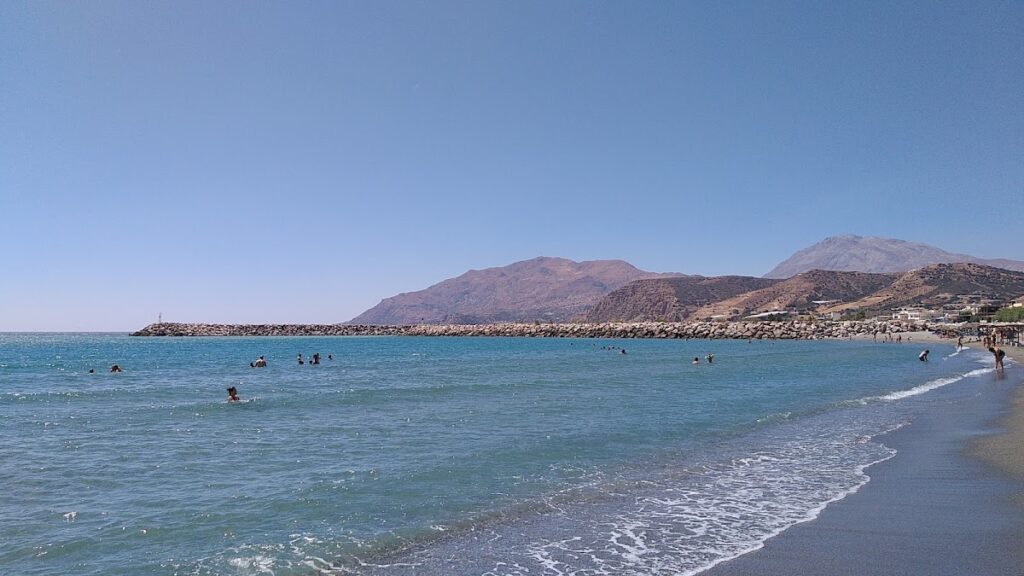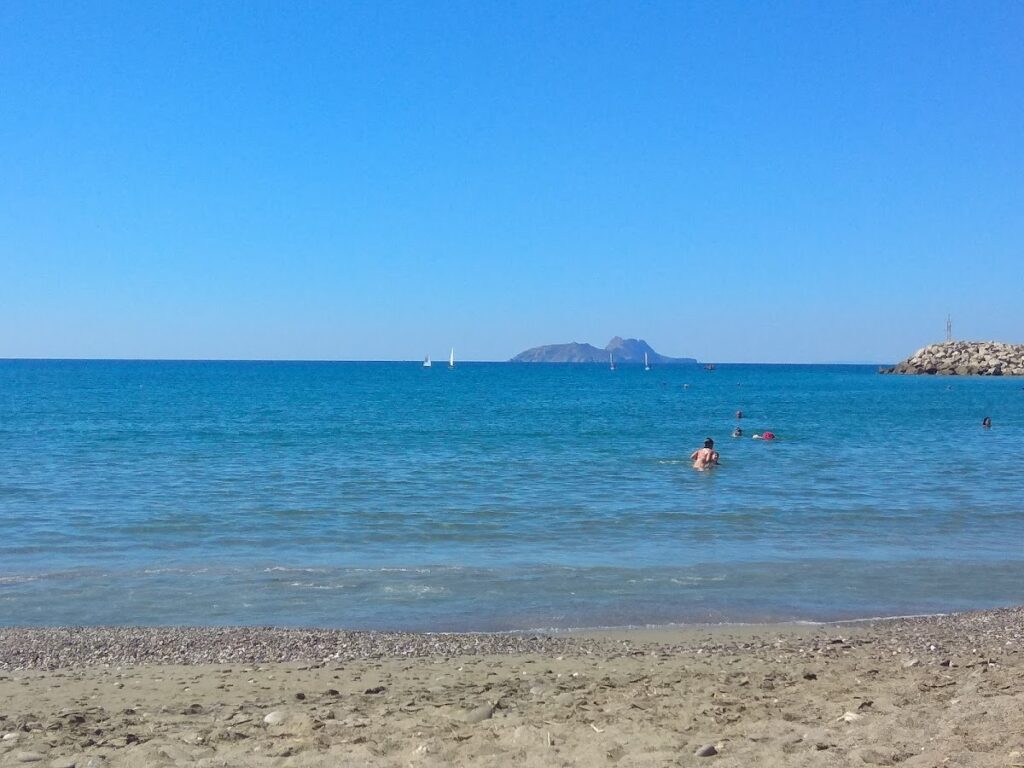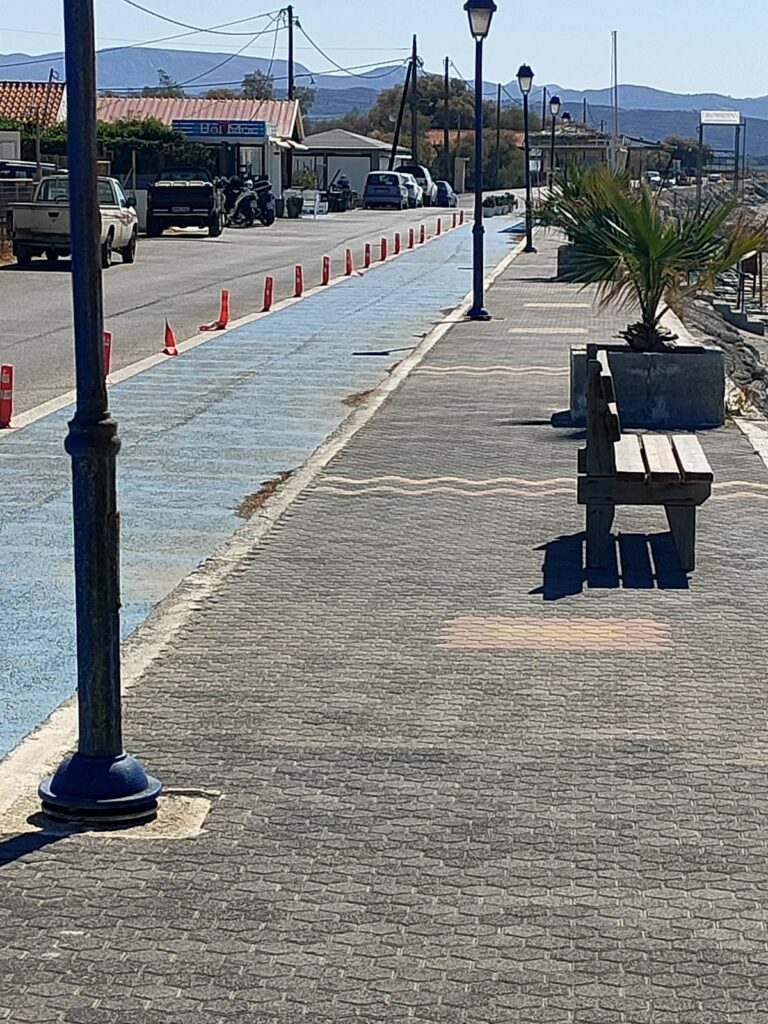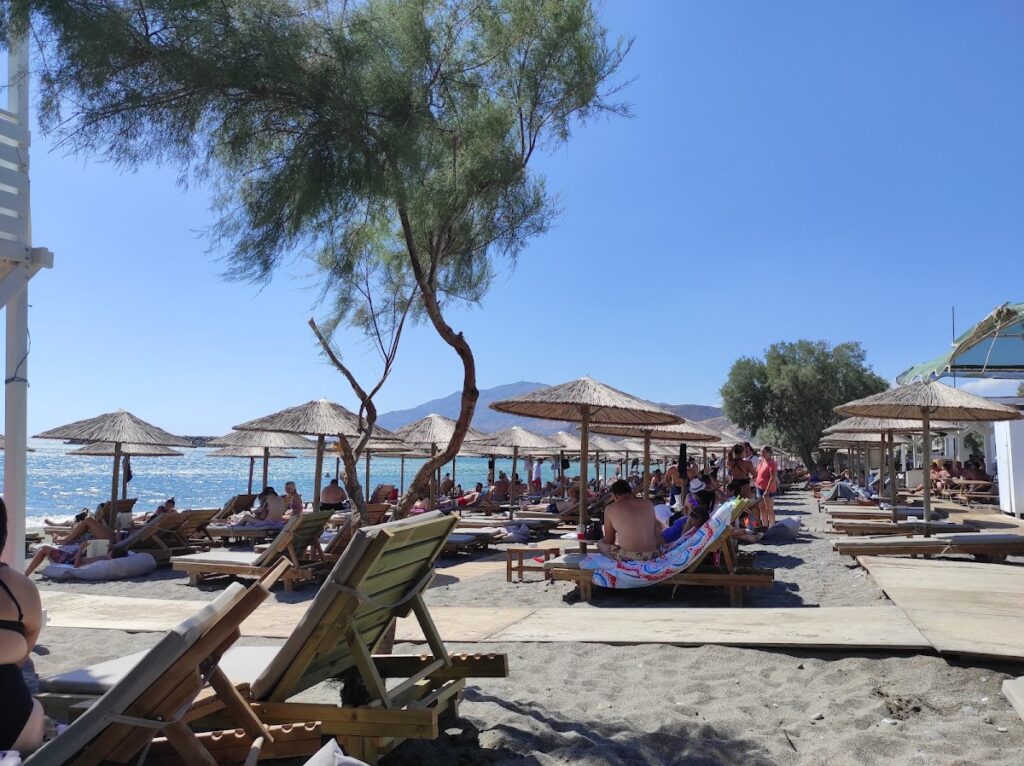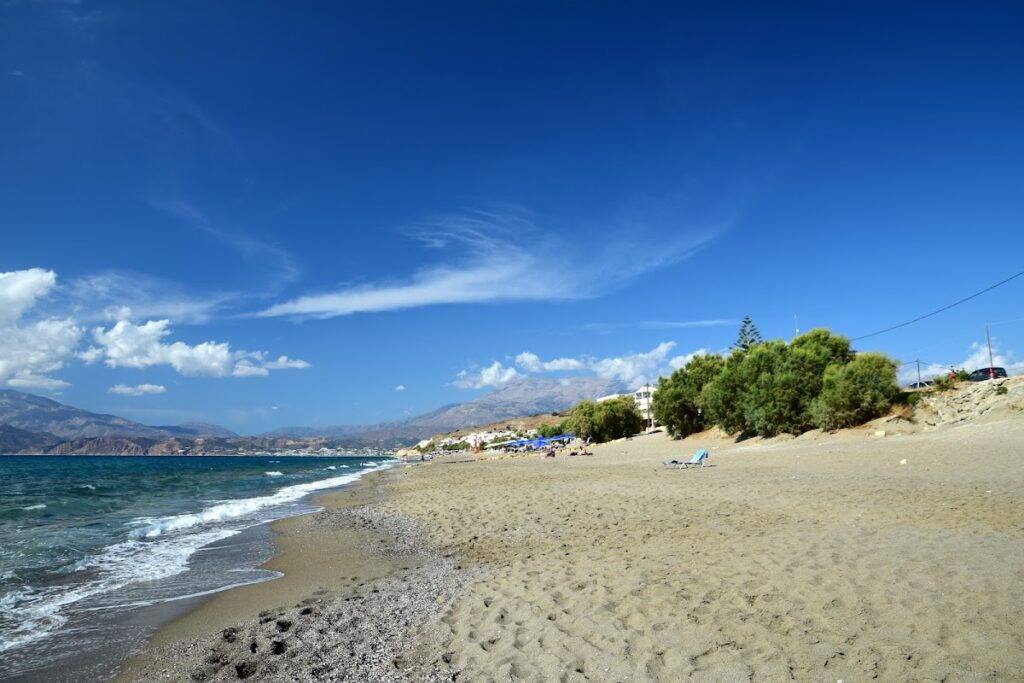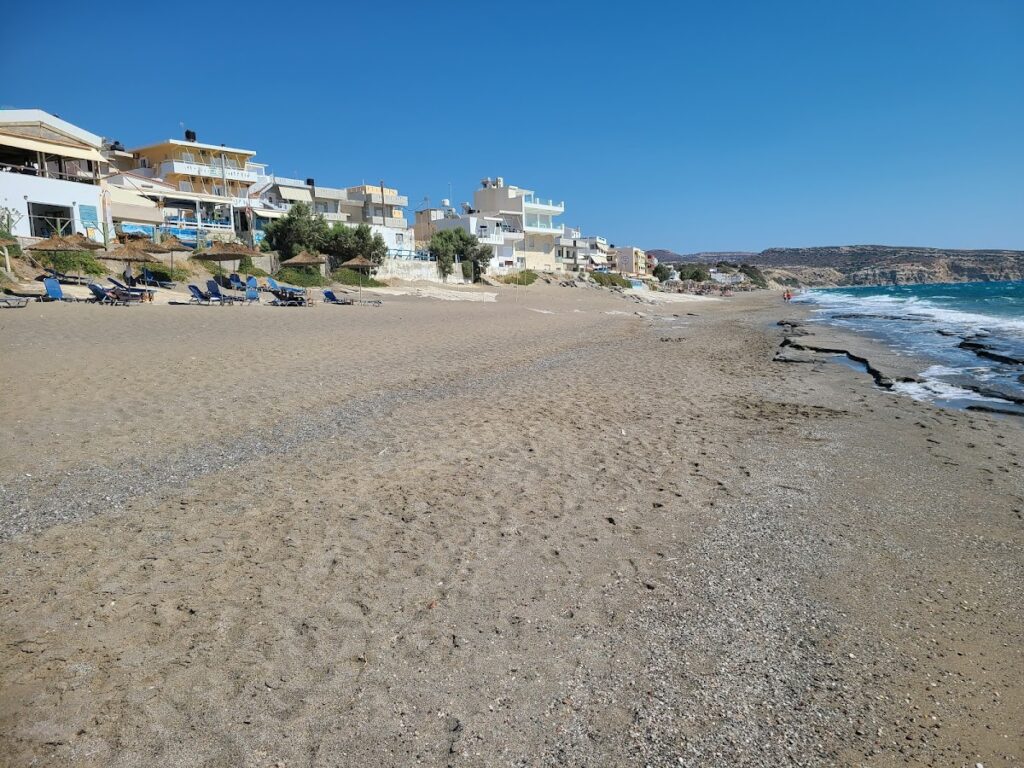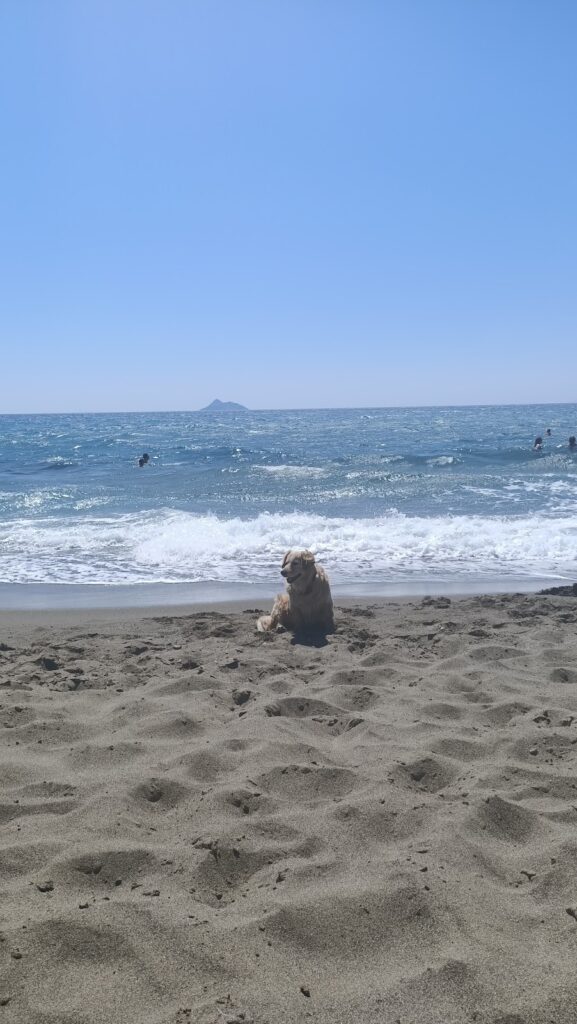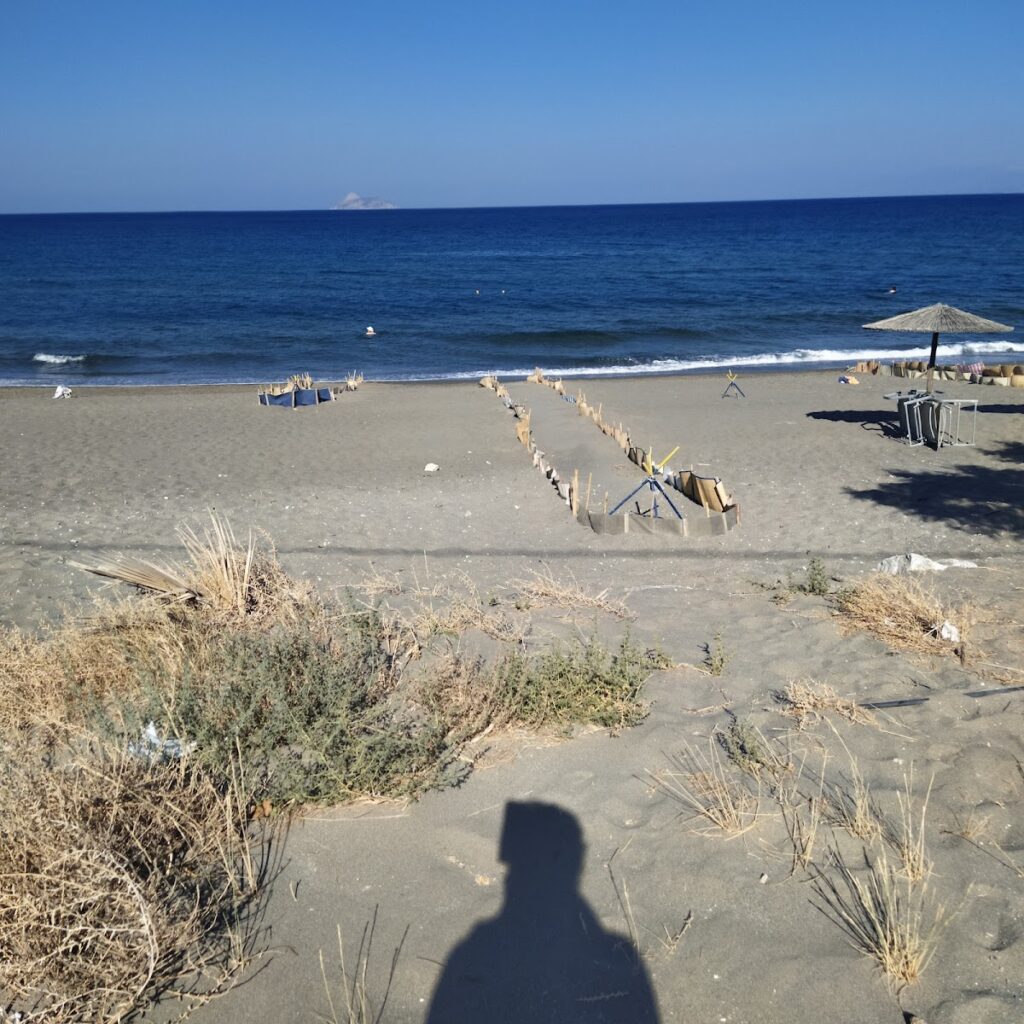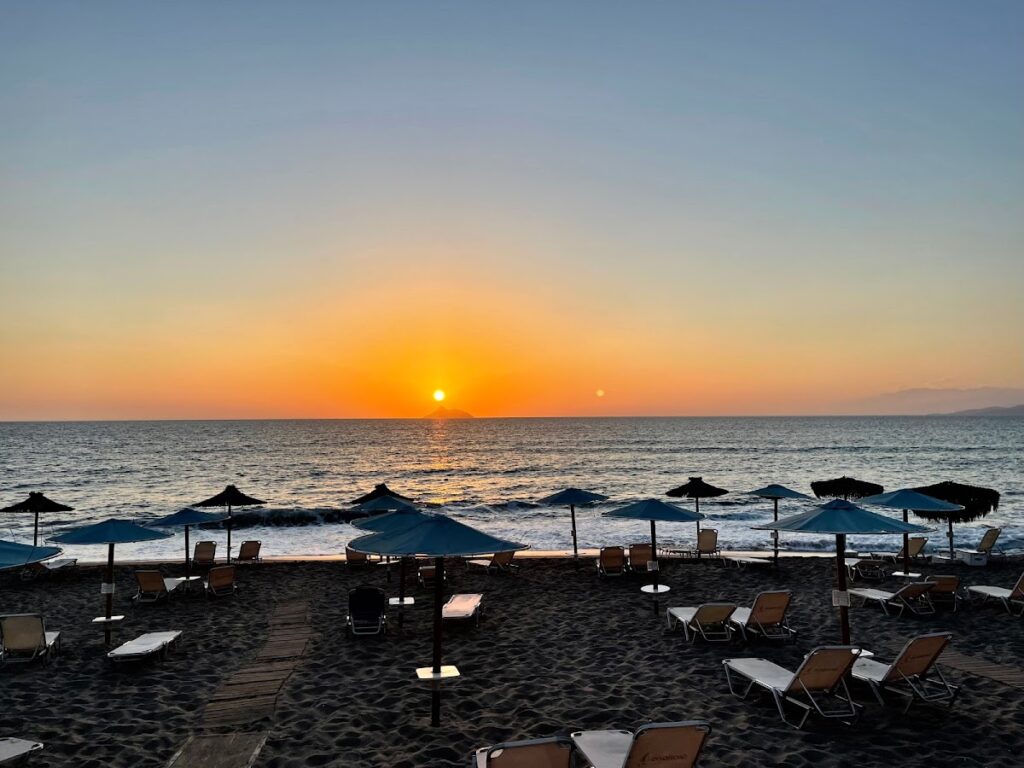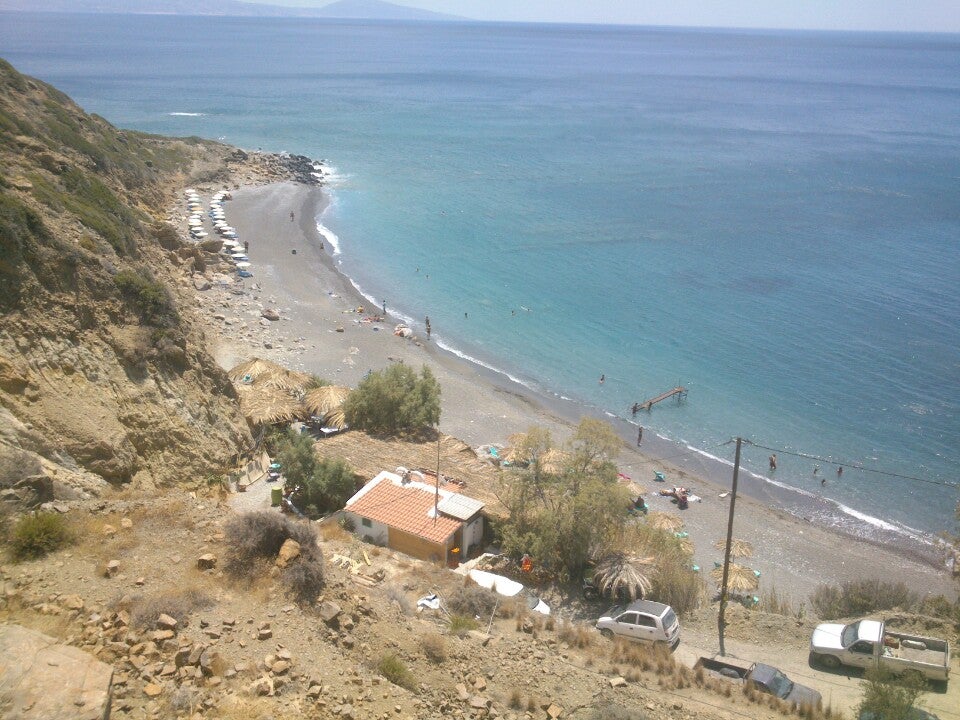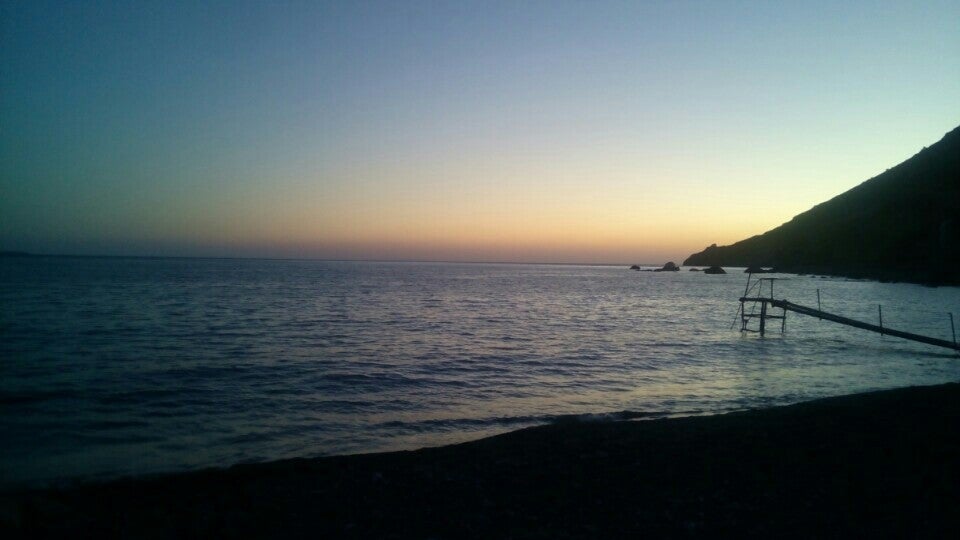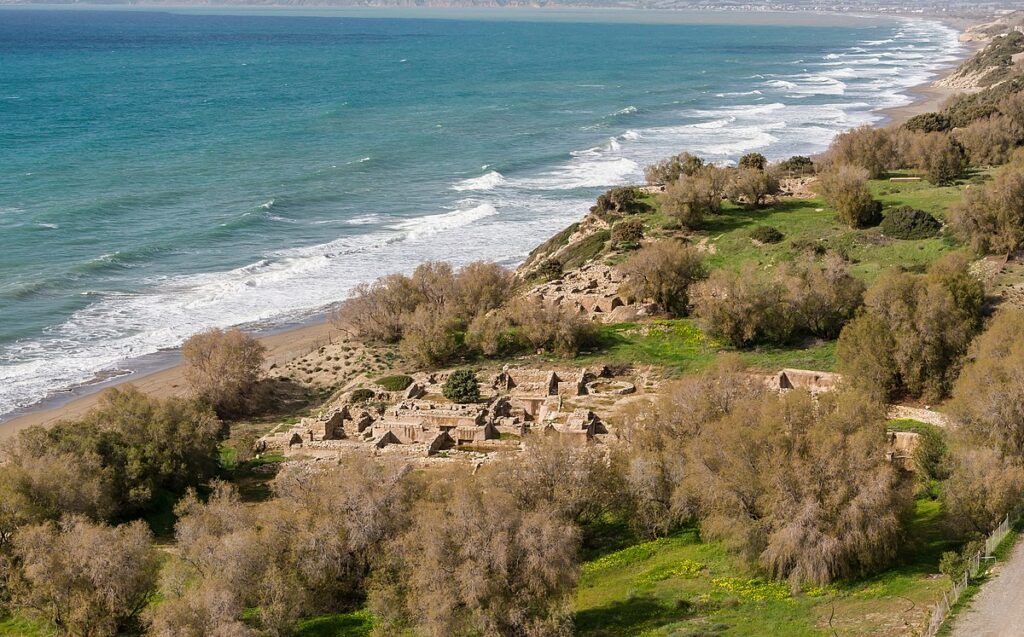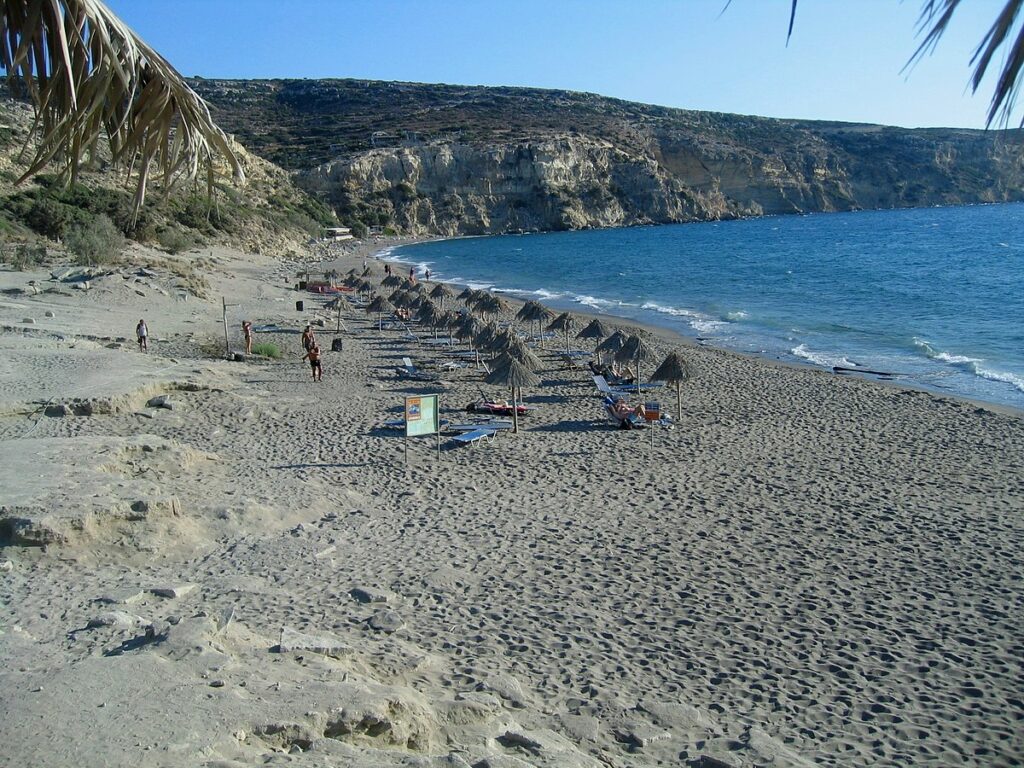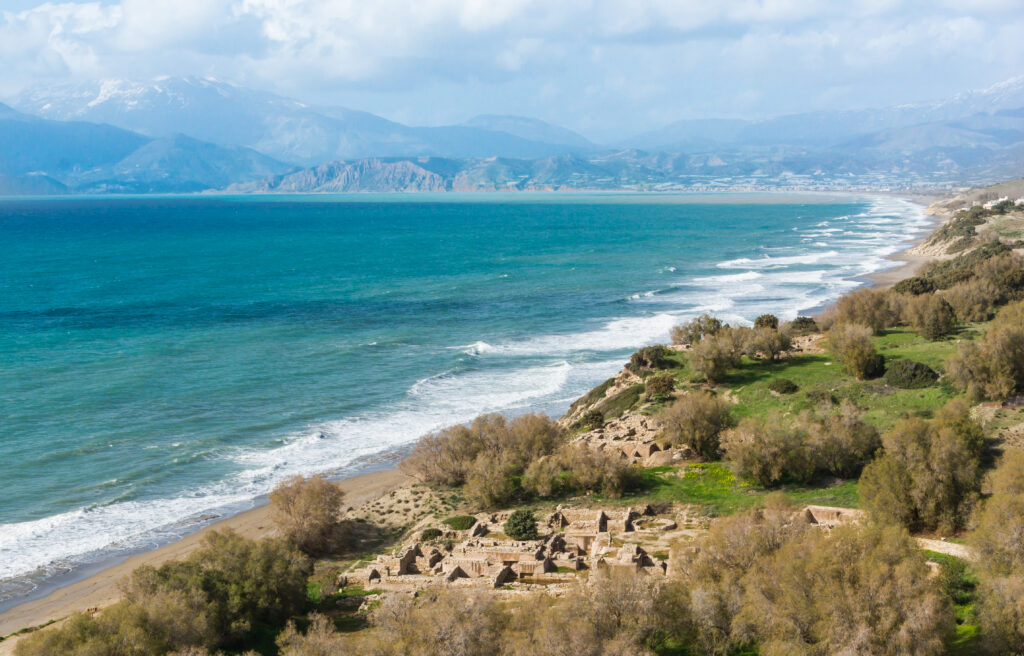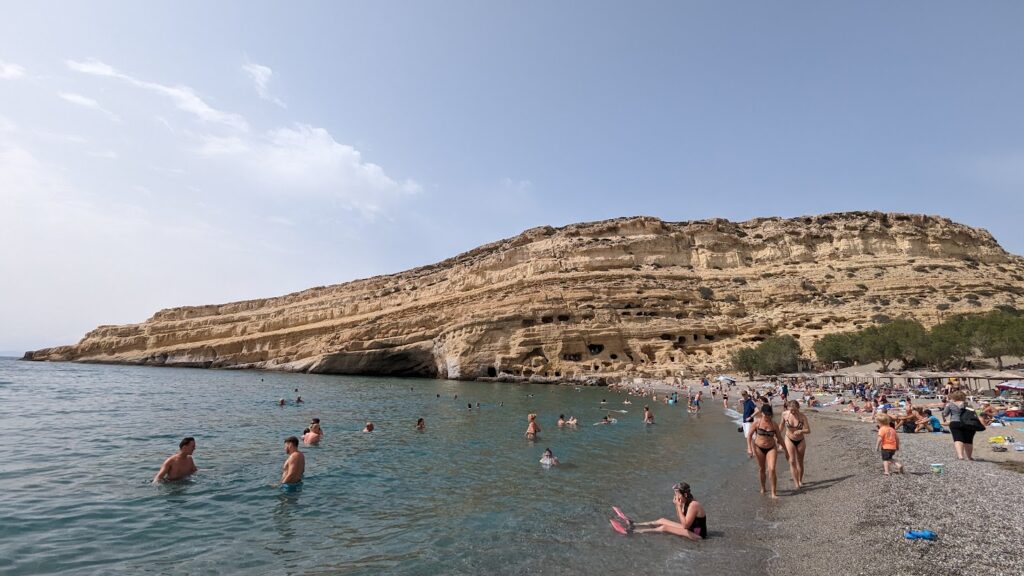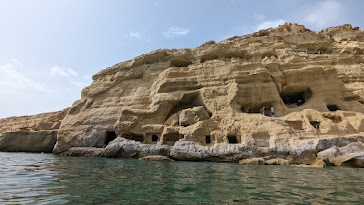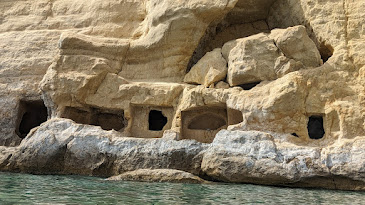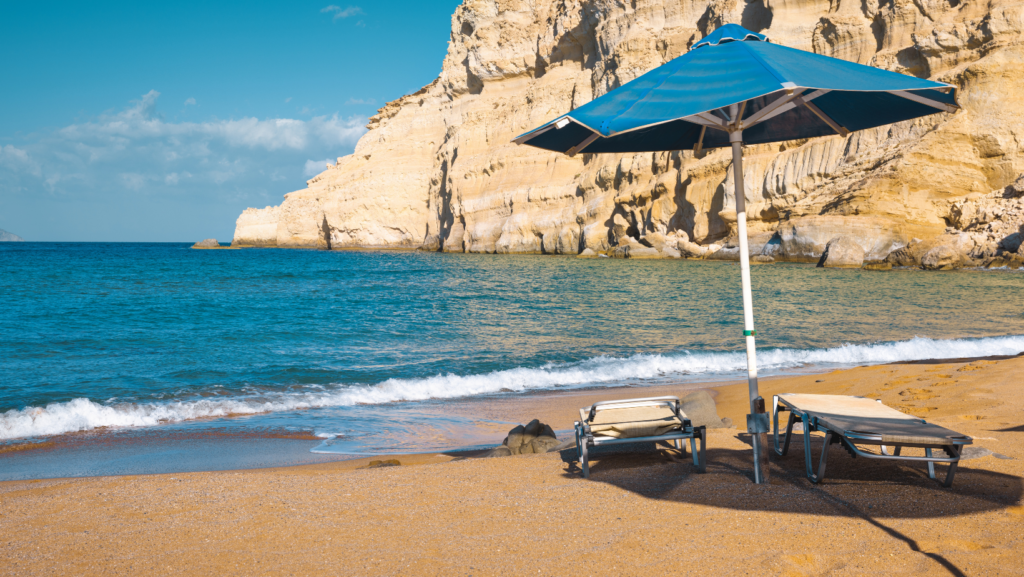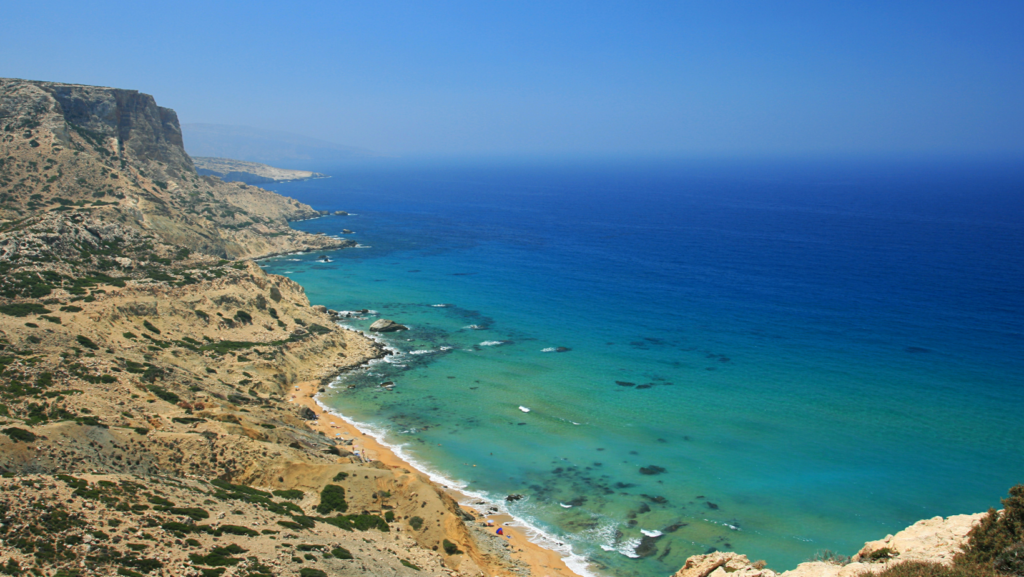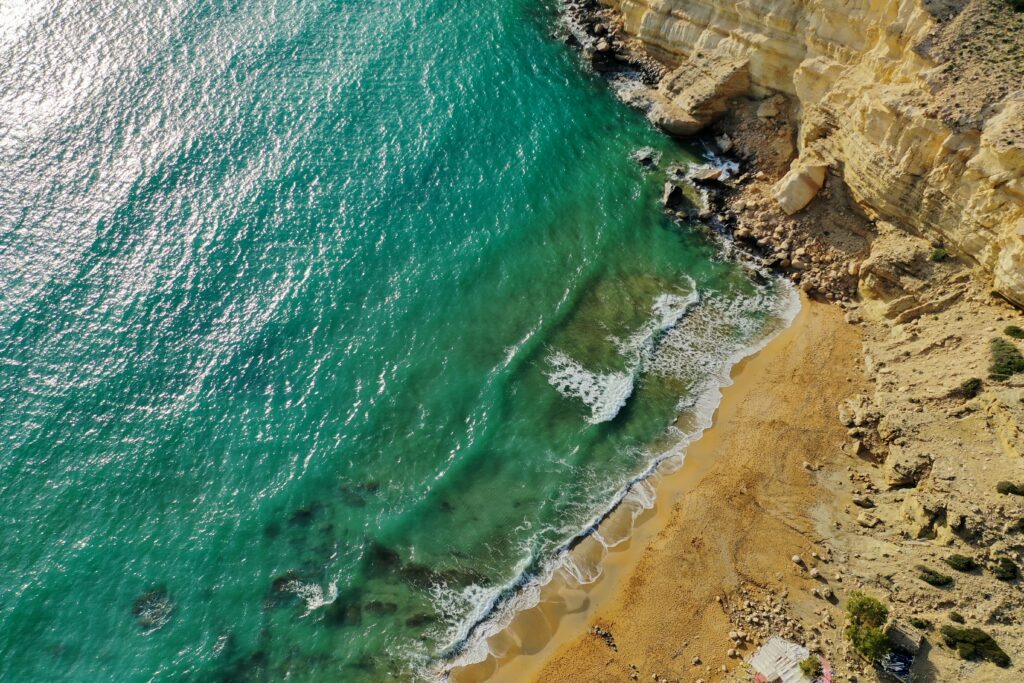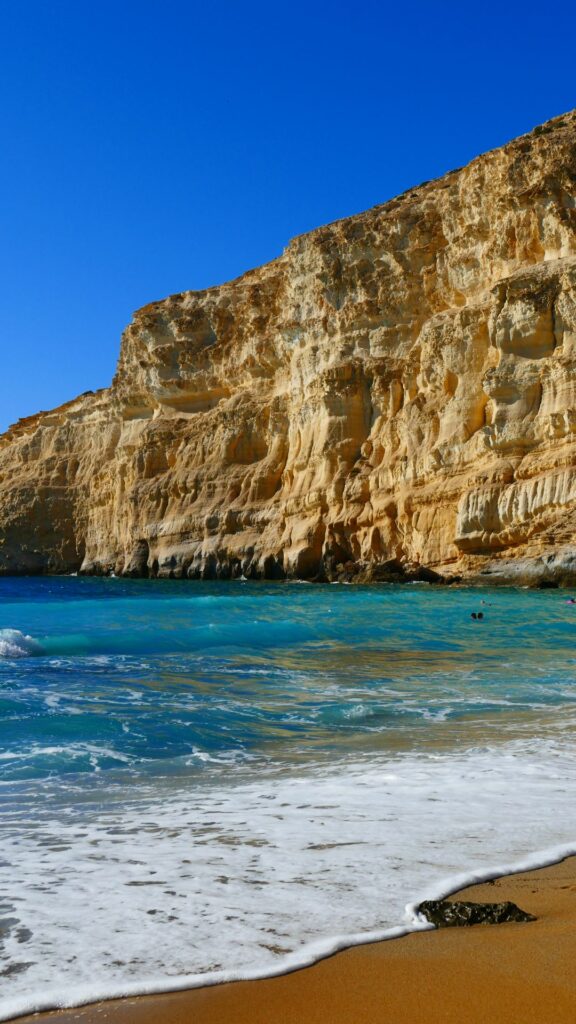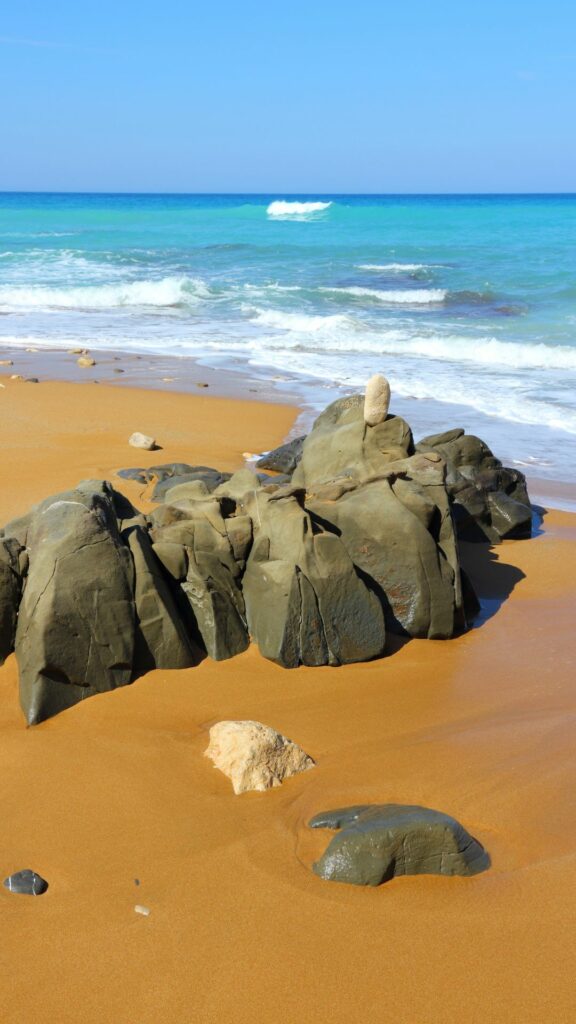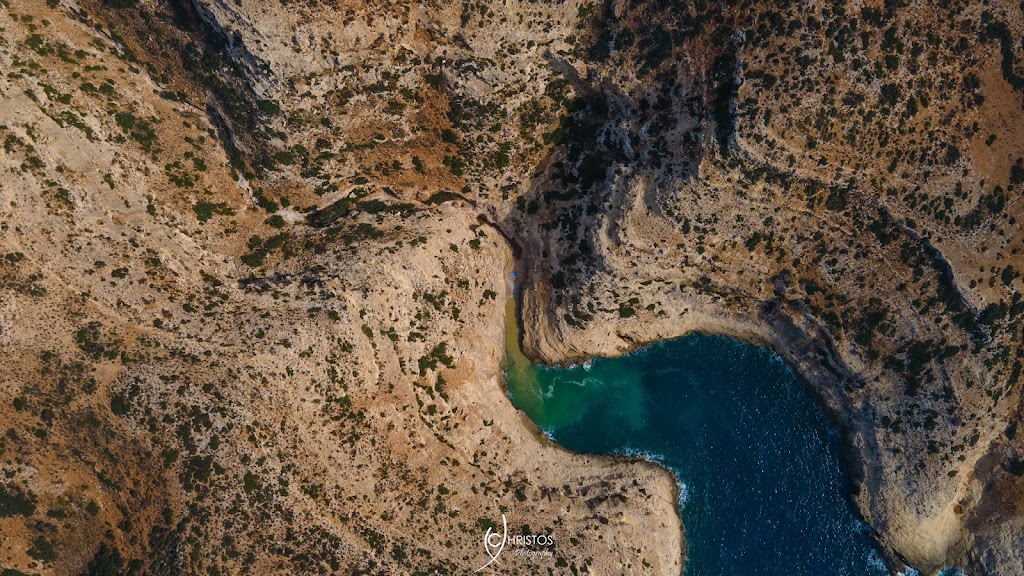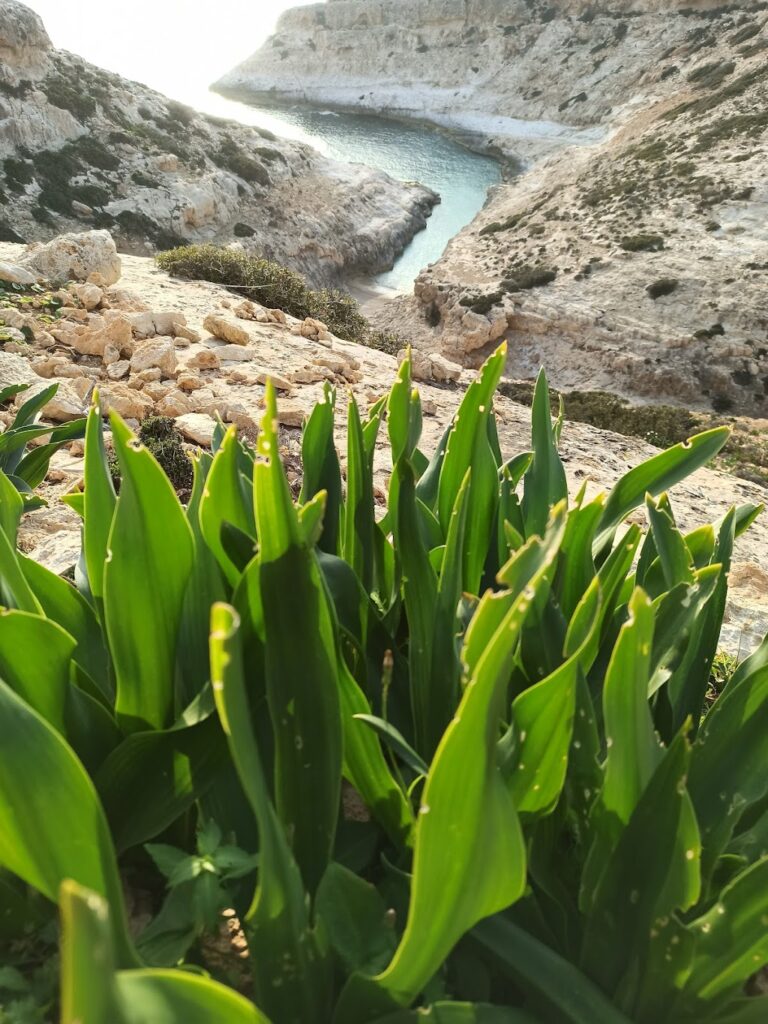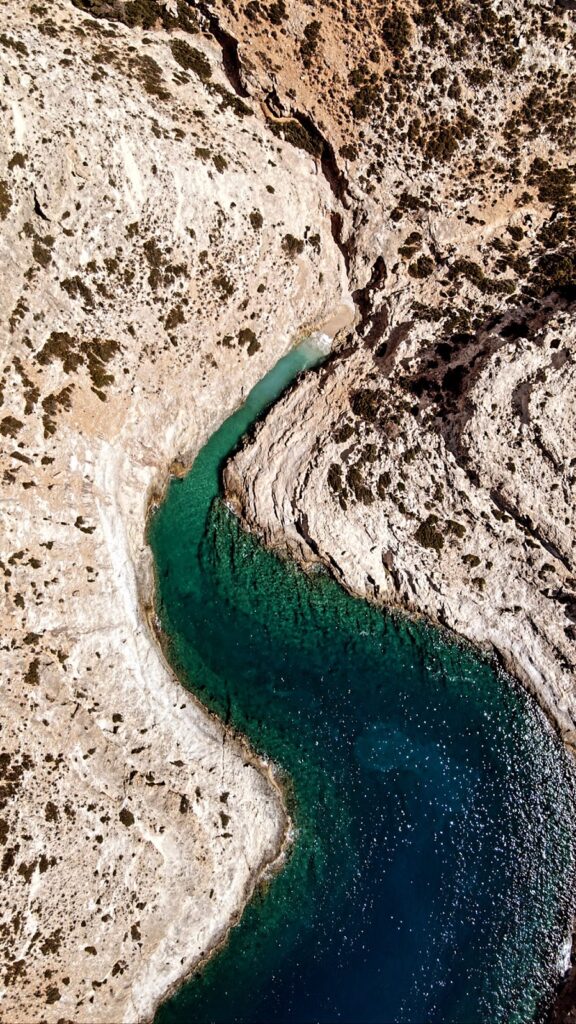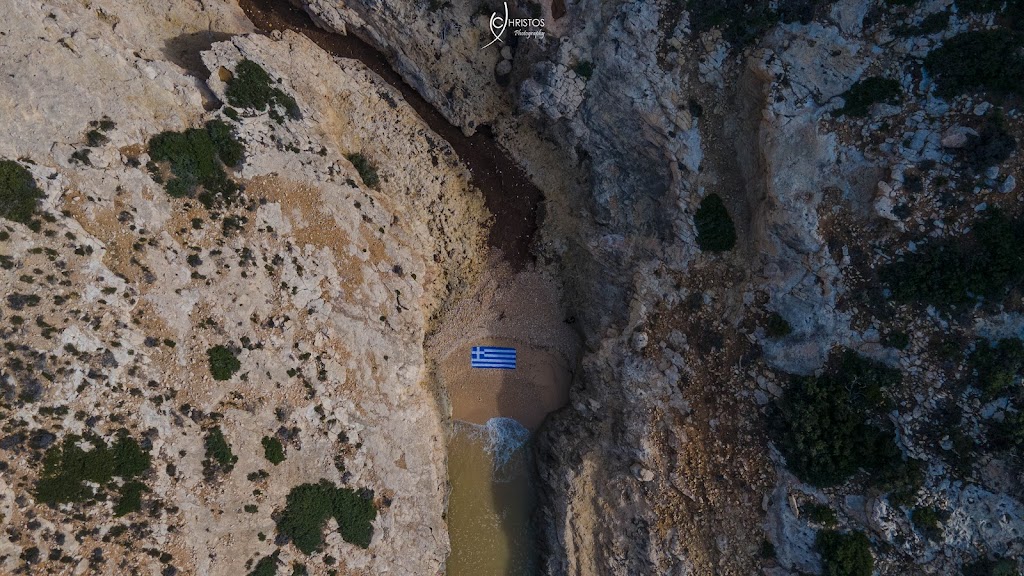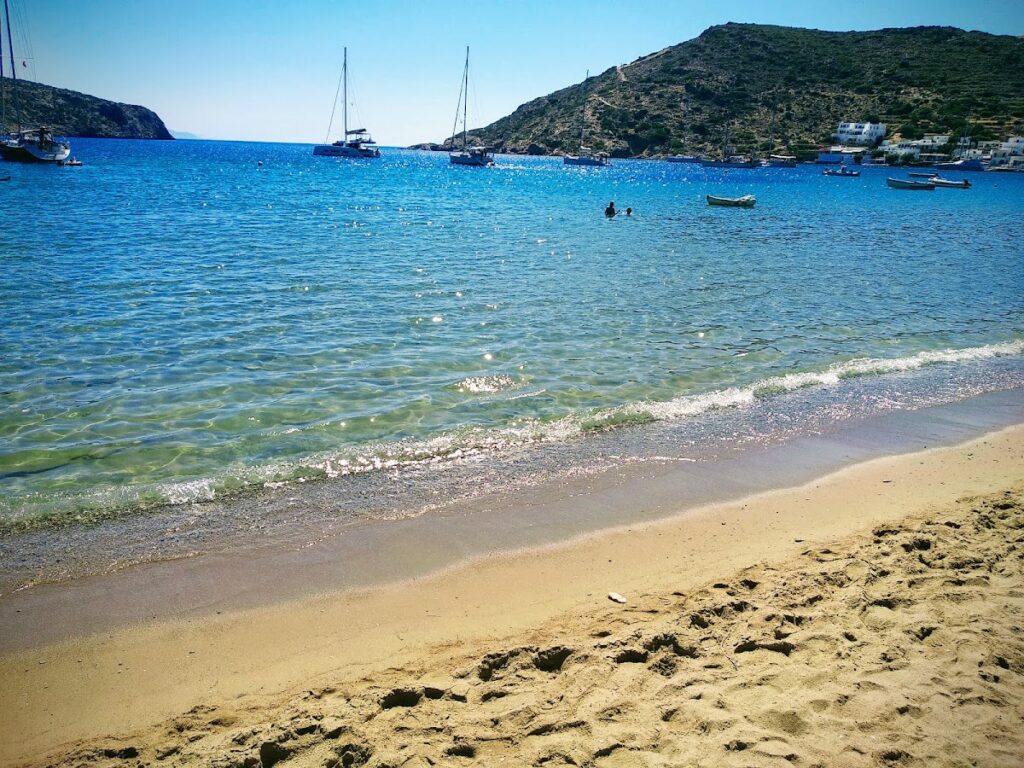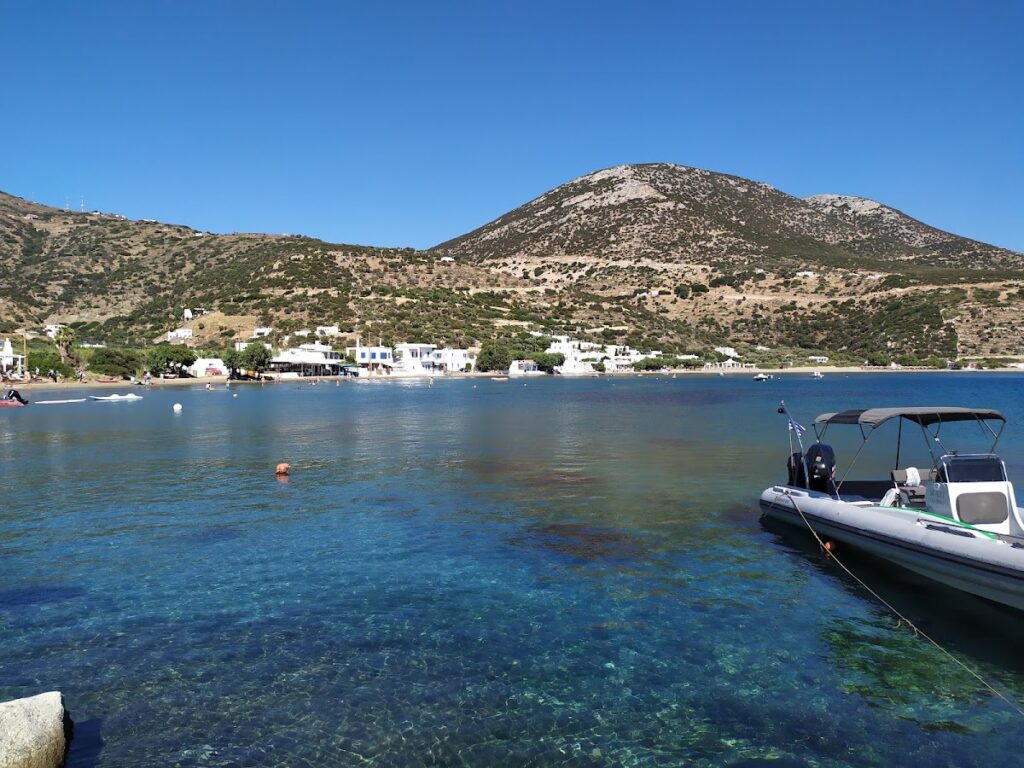Beaches near Kókkinos Pýrgos, in Heraklion region
Here is list of closest beaches to Kókkinos Pýrgos
- 880 m
- Kokkinos Pirgos beach
- Fine Pebbles, Rocks in places
- Normal
- Blue
Kokkinos Pirgos, also known as Red Tower, resides 67km west of Heraklion, near the town of Tymbaki. Its name is derived from a tower constructed from red soil, situated at the mouth of the Geropotamos river. As the coastal village of Timbaki’s main port and a hotspot for tourism, Kokkinos Pirgos is home to numerous hotels, dining establishments, and cafes. The area’s climate is typically warm, enabling locals to cultivate fresh vegetables in greenhouses.
The village boasts a lengthy sandy beach that stretches southeast towards Kommos for several kilometres. This expansive beach is a nesting ground for loggerhead sea turtles (Carretta Carretta) during the summer months. Conservation organizations such as Archelon work to protect these sea turtles and their nests. The beach, which is susceptible to western winds, begins at Timbaki’s military airport wire fence on the east and extends to Agia Galini on the west.
The beach’s eastern portion, stretching from the port to the airport, is known as Katalyki. This well-equipped beach features amenities such as umbrellas, sunbeds, lifeguards, and water sports. A coastal road lined with cafes and restaurants runs alongside the beach, making it a popular spot for refreshments. East of Katalyki lies a sizable marsh, a key wetland in the Mesara plain, which is irrigated by the Geropotamos River.
The beach area west of the harbor is known as Makrimaliana. The beach near Kokkinos Pirgos is relatively broad, but as it extends towards Agia Galini, gravel massifs encroach upon it, narrowing the beach and in some places, eliminating it during high tide. This unorganized, remote beach may not be extraordinary, but the wind and sea-carved rock formations that flank it are certainly impressive.
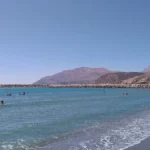
- 4.4 km
- Agia Galini beach
- Fine Pebbles, Pebbles
- Normal
- Blue
Agia Galini, a well-loved seaside resort in the southern part of the Rethymnon prefecture, is located near the Amarianos or Platys River mouth. It’s 61km south of Rethymno city and 68km southwest of Heraklion. This quaint town flourishes with activity in the summer and offers all necessary tourist facilities. The stunning green beaches, the fascinating caves in the west, the legends of Icarus and Daedalus, the hippie memories and the peaceful sea, make this village a popular spot for numerous visitors.
Starting east of the port, a long beach extends to Kokkinos Pirgos. The sea here is typically serene. The beach section near the port is well-facilitated and features fine pebbles and chilled water, due to the nearby Platys or Amarianos River, located 200m east of the port. Near the river, remnants of an ancient Artemis temple have been discovered.
Crossing the river via a metal bridge leads to the second beach, which stretches another 1km to the east. This beach, with small pebbles and less organization, is adjacent to the Agia Galini camping site. As you progress eastwards, the beach becomes narrower and more rugged. A 1.5-2 hour walk will take you to Kokkinos Pirgos. This beach, inaccessible by road and favored by nudists, is completely unorganized so be sure to bring food, water, and umbrellas.
On the beach’s west end, beneath a hill with houses, there’s a small network of tunnels from World War II. You can explore these to reach the hilltop.

- 6.4 km
- Kalamaki beach - Heraklion
- Fine Pebbles, Rocks in places
- Normal
- Blue
Kalamaki, a quaint seaside hamlet, is nestled between Matala and Kokkinos Pirgos, 65km southwest of Heraklion. The beach, a 2.5km stretch of the vast Messara Bay coastline, graces the village’s front. Its sandy shore is kissed by the sea, which conceals a slick, flat rock bed beneath its surface. It features large waves, usually stirred by northwest winds, making beach access challenging at times due to the rocky seabed.
The village-facing part of the beach is well-equipped with sunbeds, umbrellas, eateries, accommodation, a lifeguard, playground, and water sports. For a more isolated experience, head southeast towards Kommos beach, a favorite among nudists.
To the north, you’ll find Afratias and the Pahia Ammos beach, which features patches of rocks. Devoid of amenities, the beach does boast a small park used for hosting cultural events like concerts during summer months.
Further north lies the Timbaki military airport, now serving as a resort for Greek Air Force staff. Although the beachfront is accessible, trespassing beyond the fence is prohibited and could lead to arrest. Sometimes, parachuters and skydivers can be spotted descending from small aircraft, courtesy of a local club based at the airport. In 2008, a small plane crashed into the Kalamaki sea, with the pilot miraculously surviving the ordeal. The Tymbaki airport holds ecological significance for the Mesara plains as it’s intersected by the Geropotamos River, which flows out to the beach. This river, the area’s largest, serves as a sanctuary for hundreds of rare birds across its numerous ponds.
The sandy coast of Messara Bay is a protected breeding ground for the loggerhead sea turtle. To prevent nest destruction and avoid frightening these creatures, it’s best not to roam the beach’s darker areas during summer nights.
Although Kalamaki doesn’t boast a significant history due to its relatively new establishment, it’s a popular seaside resort for Kamilari locals. Some believe it once served as a small harbor for Phaestus or Gortys in ancient times, though no concrete evidence supports this claim.
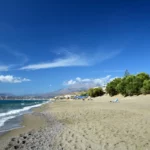
- 7.7 km
- Agios Georgios
- Fine Pebbles, Pebbles, Rocks in places
- Normal
- Blue
Situated 3km west of Agia Galini, 69km southwest of Heraklion, and 60km south of Rethymno, you’ll find the tranquil valley of Agios Georgios. This spot is home to two small bays, each boasting beautiful pebbly beaches separated by a rocky shore. The weather is often mild, making these beaches perfect for year-round swimming.
The area remains relatively undeveloped, but on the eastern beach, known as Lichnistis, you’ll find a handful of rooms, a tavern, and some umbrellas for shade. A visit to Agios Georgios offers the chance to explore the rugged Cretan countryside and take a stroll to the historic Monastery of St. George, located 500m to the north. The church’s sloping walls show signs of age and soil sedimentation, and inside, you’ll find ancient frescoes.
For those seeking solitude, the western beach, Kolimbistiri, or “swimming area”, is the ideal location. Here, you can swim in peace, and the seabed offers excellent snorkelling opportunities. To reach Agios Georgios’ beaches, take the asphalt-paved road from Agia Galini to Agios Pavlos, or hop on a boat from Agia Galini.
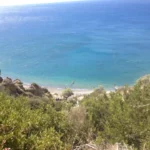
- 8.1 km
- Komos beach
- Sand
- Normal
- Blue
Situated 66km southwest of Heraklion, Kommos (or Komos) lies a mere 2km north of Matala and in close proximity to Pitsidia village. It stands as the southernmost and remotest section of the extensive beachfront of Messara Bay. Once serving as the port of Phaestus, the remnants of the ancient port of Kommos can still be observed on the beach. It can be reached by driving towards Matala and following a sign to Kommos near Pitsidia.
The entire beachfront of Messara is exposed to the prevalent westerly winds. Visitors should exercise caution as the seabed can be rocky in certain areas. The beach also serves as a nesting ground for the protected loggerhead sea turtles (Caretta caretta) between the months of May and September.
Potamos or Potamoserma, the northern section of Kommos, is a popular spot among naturists, dating back to when hippies frequented the area. The location is dotted with sparse tamarisk trees and devoid of buildings due to its protected archaeological status, restricting construction. Next to the archaeological site in the south, there is a developed beach equipped with amenities such as umbrellas, sun beds, a toilet, showers, a canteen and a lifeguard. Surrounding sand dunes are home to white sand lilies that mark the end of summer. Nearby Kalamaki or Pitsidia and Matala offer options for accommodation and dining.
The sight of Paximadia islets during sunset is breathtaking. A large rock, known locally as Volakas, stands 300m out at sea, opposite the archaeological site. According to local lore, this rock is the tip of the boulder that the blinded Cyclops Polyphemus hurled at Odysseus’ ship to prevent his escape, following Odysseus and his crew’s escape from Polyphemus’ cave.
Kommos, the ancient port of Phaestus, was established around 200BC. However, it was subsequently destroyed by an earthquake and then rebuilt at the same location. The archaeological site of Komos, not open to the public, houses a Minoan harbour, public buildings, warehouses, oil presses, shipyards and a large courtyard. Archaeologists have uncovered a small temple, constructed on the ruins of an older one.
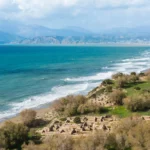
- 10.1 km
- Matala beach
- Fine Pebbles, Sand
- Deep
- Blue, Green
The beach of Matala is situated 68km southwest of Heraklion, where the Messara plain and Asteroussia Mountains intersect. It is one of the most frequented tourist spots in Crete and the most well-known beach in the southern region of the Heraklion prefecture. Matala is notable for its rock-carved caves and its association with the hippie culture of the 1970s. It lies in close proximity to Phaestus, the second largest palace of the Minoan civilization, having once served as its port. During the era of the Romans, Matala transformed into a port for Gortyn.
Nestled at the end of a small valley, Matala overlooks an enclosed bay with a picturesque view of the Paximadia islands. The beach spans 300m and features beautiful sandy shores, fine gravel, and crystal-clear deep waters. However, parts of the seabed, particularly the central area, are quite rocky and waves are common due to frequent westerly winds. A large cave can be found on the northern part of the beach, from which some thrill-seekers dive.
Matala beach is well-equipped with amenities such as umbrellas, restrooms, showers, lifeguards, first aid facilities, beach volleyball courts, snack bars, water sports, excursion boats, and a camping site. The surrounding area of Matala offers a range of accommodation, dining, and entertainment options. The beach is largely shaded by tamarisk trees, providing a respite from the sun. Come evening, the beach bars are brimming with people, both locals and tourists. The internationally acclaimed Matala Festival draws large crowds every June.

- 10.9 km
- Red beach
- Sand
- Normal
- Blue, Green
The Kokkini Ammos, or Red Beach, can be found 68km southwest of Heraklion and a short 800m from the popular resort of Matala. You can reach this hidden gem by following a clearly marked trail from Matala, which takes you over Kastri hill. While the trail includes some initial rock climbing and a steep descent at the end, it’s quite feasible. After a 15-25 minute walk from Matala, passing through a shepherd’s gate along the way, the breathtaking Red Beach comes into view. It’s an ideal spot for enjoying panoramic views and beautiful sunsets. Alternatively, you can also reach the beach by boat from Matala Harbour for a small fee of around 5 euros.
The beach is most noted for its red sand, a result of the area’s unique geology, which forms a stunning contrast against the bright blue-green sea. However, it’s important to note that it’s not shielded from the typical western winds in the region. The beach has minimal facilities, with a simple stone-wall coffee shop that opens occasionally offering food and drinks, and some umbrellas. It’s recommended to bring your own mats and umbrellas as the only natural shade is provided by a few tamarisk trees near the canteen.
In the 1960s and 70s, Red Beach was a popular spot among hippies, and its legacy continues with enthusiasts still visiting the beach regularly. Especially the northern part of the beach has gained a reputation as a nudist-friendly area and has gained international recognition for this. The beach and its surrounding area are protected by the Natura 2000 program due to its ecological importance.
The northern end of the beach features a long rocky limestone formation, similar to the limestone found in Matala. These rocks are decorated with carvings of Minoan and Egyptian sea figures, created by Gerard, a Belgian fan of Matala. These carvings have become a key part of the beach’s appeal. Between Matala and the Red Beach, there’s a large rock known as Theosini that offers stunning views of Messara Bay. This rock has been eroded by the sea, creating a marine cave known as Kouroupi, which can only be accessed by boat. The cave is a haven for endangered Mediterranean seals and various species of wild pigeons.
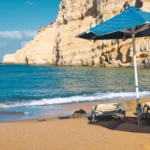
- 13.2 km
- Louros beaches
- Pebbles, Rocks in places
- Normal
- Blue
Louros, nestled between the settlements of Agios Georgios and Agios Pavlos, is characterized by its rocky terrain and a collection of small, pebbly beaches. A scenic coastal road provides stunning views of the two Paximadia islets. Heading west from Agios Georgios, travelers will encounter the quaint beaches of Armenopetra, named after a solitary boulder found in the sea. These beaches offer excellent opportunities for snorkeling and spearfishing.
Two kilometers before reaching Agios Pavlos, another beach, either known as Agios Markos or Ligiolakos, is found across from the rock known locally as Prasonisi. The waters here are typically tranquil, making it a favorite spot for local families from Melambes. The seabed is also a great place for snorkeling and spearfishing. Further east of Prasonisi, more similar beaches can be found, usually accessed on foot.
The next beach, Aniforas or Vigdolidi, is difficult to reach due to private property blocking the path. The beach is situated near a striking rocky cape, and while the beach itself is unremarkable, the towering rock formation provides excellent photo opportunities.
The final beach, located 500m east of Agios Pavlos, is positioned at the mouth of a stream. Ancient Cretan date palm trees, known as Theophrastus, line the banks of the stream, giving the pebbly beach its name – Finikidia.

- 13.7 km
- Gournia Fjord near Vathy beach
- Rocks in places, Sand
- Normal
- Blue
Gournia, a remote area situated on the outskirts of the Pigaidakia village in the Asterousia Mountains, lies between Vathi beach and the rugged location of Sideropetra. This is along the route that links Matala with Vathi. Reaching Gournia from the mainland demands a high level of fitness due to the strenuous and shadeless journey. However, the raw charm of the landscape makes up for the difficulty.
The region is marked by the soft white limestone that has been eroded by the sea, giving it a resemblance to a lunar landscape. In Gournia, there are five successive, narrow, and rocky bays formed at the outlets of deep streams, reminiscent of tiny fjords. Several small natural ponds, or troughs, which give the place its name, Gournia (meaning troughs), are also present.
In the largest and most dramatic fjord, a small, captivating beach is occasionally formed, depending on the eastward carrying portable materials by the winter rains. This unnoticed beach was photographed by Manolis Dretakis and Nektarios Savvakis in May 2020, providing a delightful surprise as it was previously considered just a rocky bay.
To reach Gournia, one has to endure a walk from Matala, which takes around two and a half hours, or from Vathi, taking one and a half hours, where a dirt road from the Monastery of Panagia Odigitria leads to the area.
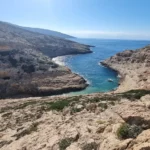
- 14.7 km
- Vathy beach
- Rocks in places, Sand
- Normal
- Blue, Green
Vathi, a breathtaking beach, lies 79km and 17km southwest of Heraklion and the Sivas village respectively. It’s located near Crete’s southernmost point, Cape Lithino, and well away from bustling cities, making it a perfect spot for those longing for ultimate serenity. The beach is nestled at the mouth of a petite gorge and enclosed by extensive cliffs. Its circular cove shields it from the open sea, rendering Vathi a natural sanctuary, with legends claiming it served as a pirate anchorage. The beach, well-protected, typically boasts calm waters, despite surrounding beaches often witnessing waves. Only southwest winds trigger storms in this region.
The gorge walls in the area are adorned with fascinating natural cavities, resulting from wind and salt erosion of the white limestone. The vicinity hosts a few makeshift huts, old campervans, and basic homes constructed by locals, primarily from the Gergeri village. These locals’ ancestors would bring their flocks to this warm location in the winter, and their descendants now enjoy their summers here.
The beach is predominantly sandy with sporadic stones. The shallow waters are bordered by numerous tamarisk trees providing shade. Nudity is prohibited here, respecting the area’s religious heritage (linked to the Odigitria Monastery).
To reach Vathi by car, drive along the paved road from Sivas village towards the Odigitria Monastery. From the monastery, take the first dirt track on your right, heading west towards Kefali Peak and up the untamed Cape Lithino. Continue for about 15km on the rough gravel road, following the signs to Vathi. Alternatively, if you’re without a car or prefer not to drive, consider hopping on an excursion boat to Vathi from Matala, Kokkinos Pirgos, or Agia Galini.
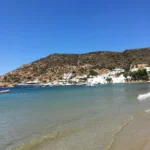
No results available
ResetBeaches in other nearby areas
No results available
Reset